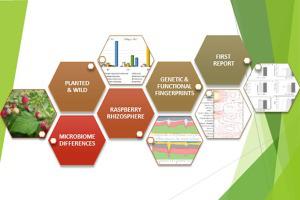Ecological Indicators ( IF 7.0 ) Pub Date : 2020-11-05 , DOI: 10.1016/j.ecolind.2020.107117 Karolina Oszust , Magdalena Frąc

|
The considerable worldwide scale of raspberry crops merit thorough research, especially in the context of their root associated microorganisms. The current state of knowledge concerning microbial biodiversity occurring in the rhizosphere of such a desirable plant is rather fragmentary. Nevertheless, a reasonable outlook for growers is anticipated with regard to the threat of disease or the initial exploration of raspberry growing sights for beneficial microbial isolates for the future of probiotechnology applications.
Therefore, we combined the Next Generation Sequencing method with the Biolog® technique in order to describe the taxonomic and functional state of microbial communities under both planted and forest raspberries.
The main taxa of potentially pathogenic fungi associated with raspberry were revealed to be Fusarium oxysporum, Tremalles and Hymenoscyphus. For prokaryotic pathogenic taxa, these were classified as follows: Nocardioidaceae and Xanthomonadaceae.
Also, Ktedonobacteria, Micromonosporaceae and Chitinophagaceae occurring in raspberry rhizosphere were included with taxa from which beneficial isolates might be obtained to serve in the future as the active ingredient of biopreparations or microbial inocula for raspberry plantation naturalization.
The most frequent microbial processes that occur in the raspberry rhizosphere were revealed. These were: hydrolase, oxidoreductase or phosphotransferase reactions, isomerization processes and/or the transfer of specific functional groups. The high degree of microbial activity on Putrescine was confirmed thereby indicating that ammonia-forming or deamination processes are more characteristic for raspberries than other plants.
The alpha and beta diversity of the microbial communities under raspberry was demonstrated both at the metataxonomic and functional levels. The concept of the Effective Number of Substrates, following the Biolog® MicroPlate method, as a functional biodiversity indicator of the rhizosphere microbial communities was implemented and supported by metataxonomic information. This resulted from our hypothesis that the application of Jost’s ‘true diversity’concept of Effective Number of Species to a functional approach will change the allowance of diversity divergence of microbial communities from tested sites in relation to Richness.
中文翻译:

关于野生和种植覆盆子根际微生物群落的第一份报告–关于分类单元,过程和功能多样性新指标的声明
值得一提的是,全球范围内的覆盆子作物规模相当大,值得深入研究,尤其是在其根系相关微生物的背景下。关于在这种理想植物的根际中发生的微生物生物多样性的当前知识状态是零碎的。然而,对于疾病的威胁或对于有益微生物分离物的覆盆子生长点的初步探索,预期对于种植者而言是合理的,以用于未来的生物技术应用。
因此,我们将下一代测序方法与Biolog®技术相结合,以描述种植和森林覆盆子下微生物群落的分类和功能状态。
与覆盆子有关的潜在致病真菌的主要分类是尖镰孢,三叶草和膜孢菌。对于原核病原体分类单元,分类如下:诺卡氏菌科和黄单胞菌科。
另外,在树莓根际中存在的分枝杆菌,微单孢菌科和几丁质菌科也包括在分类单元中,从中可以获得有益的分离物,将来可作为生物制剂或微生物接种物的活性成分用于覆盆子的人工林化。
揭示了在树莓根际发生的最常见的微生物过程。它们是:水解酶,氧化还原酶或磷酸转移酶反应,异构化过程和/或特定官能团的转移。证实了对腐胺的高度微生物活性,从而表明与其他植物相比,覆盆子的氨形成或脱氨过程更具特征。
树莓下微生物群落的α和β多样性在元分类学和功能水平上均得到证实。继Biolog®MicroPlate方法之后,有效底物数量的概念作为根际微生物群落的功能性生物多样性指标被实施并得到了元分类学信息的支持。这是由于我们的假设而得出的,即乔斯特的“有效物种数”的“真正多样性”概念在功能方法中的应用将改变微生物种群相对于丰富度从测试地点的多样性扩散的允许范围。










































 京公网安备 11010802027423号
京公网安备 11010802027423号